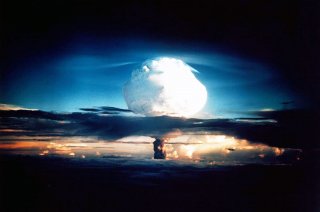Did a U.S. Military Nuclear Bomb Test Give John Wayne Cancer?
It has been reported that actor John Wayne, along with many of his costars and the crew of the 1954 film The Conqueror may have been exposed to radiation fallout that landed in the Utah desert near the sites where the movie was being made.
Most American adults alive today can remember a time when smoking was allowed in restaurants and on airplanes and you don't have to be a fan of Mad Men to know that a business lunch often involved cocktails. It was during the same era that the United States military operated the Nevada Test Site – which wasn't used to evaluate the latest tanks or even aircraft.
Nuclear Weapons Testing: A Tourist Attraction?
Rather from 1951 to 1963, the desert outside of Las Vegas was used to conduct atmospheric nuclear weapons testing. While such a test today would likely attract swarms of protesters and those concerned about the environmental impact – back in the 1950s and early 1960s the tests attracted another group of people, namely tourists.
In addition to the lights of "Sin City," a flash of unimaginable brightness could be seen during the tests and while that resulted in some fear from locals, it brought in curiosity seekers from around the country. The Nevada Testing Site was located just 65 miles northwest of Las Vegas in the Yucca Flats.
Nevada wasn't the only test site of course, but it was the only one that was able to turn the tests in an attraction and it practically became a spectacle. The tests continued until 1963 when the Limited Test Ban Treaty ended above-ground nuclear trials after the Cuban Missile Crisis.
The lingering question has remained whether tourists and even more those who called Las Vegas home, were exposed to potentially harmful levels of radiation. It wasn't just civilians either who may have been in harm's way.
A Department of the Energy (DoE) report noted that in one of the first tests, "some 1,700 soldiers were positioned in five-foot-deep trenches 7,000 yards from ground zero, the closest by nearly half that any observer had ever been to a nuclear test." At the time the risk from exposure to the fallout wasn't fully comprehended, but the devastation of the Japanese cities of Hiroshima and Nagasaki should have at least been an indicator that being so close to the blast site wasn't remotely advisable!
The DoE also reported that it was already known that radiation was lethal to sheep in the open at 900 yards, while those poor animals placed in foxholes still suffered third-degree burns, and the sheep at 2,000 yards in the open still were affected with first degree burns. By the mid-1950s it was even understood that the fallout could cause cancer in those exposed to the blasts, yet strangely the tests continued, and with loose restrictions on spectators.
The Environmental Protection Agency (EPA) also has noted that the detonation of nuclear weapons above the ground sends radioactive materials as high as 50 miles into the atmosphere. While the larger of the particles typically fall back to the ground near the explosion site, it is now understood that the smaller and lighter particles as well as gases can travel into the upper atmosphere – that is the fallout that can be circulated around the world even for years until it falls back to the earth.
Fortunately, little radioactivity from the weapons testing conducted at the Nevada site can still be detected in the environment, but it likely impacted many who were exposed – even if they weren't actually there when the tests were conducted.
John Wayne, Killed by a Nuclear Weapons Test?
It has been reported that actor John Wayne, along with many of his costars and the crew of the 1954 film The Conqueror may have been exposed to radiation fallout that landed in the Utah desert near the sites where the movie was being made. Wayne, leading lady Susan Hayward, director Dick Powell and dozens of others involved in the picture all died from cancer. In Wayne's case, even he suggested it was his smoking habit – up to seven packs a day – that brought him down, but certainly being exposed to the fallout didn't help.
Peter Suciu is a Michigan-based writer who has contributed to more than four dozen magazines, newspapers and websites. He regularly writes about military small arms, and is the author of several books on military headgear including A Gallery of Military Headdress, which is available on Amazon.com.

